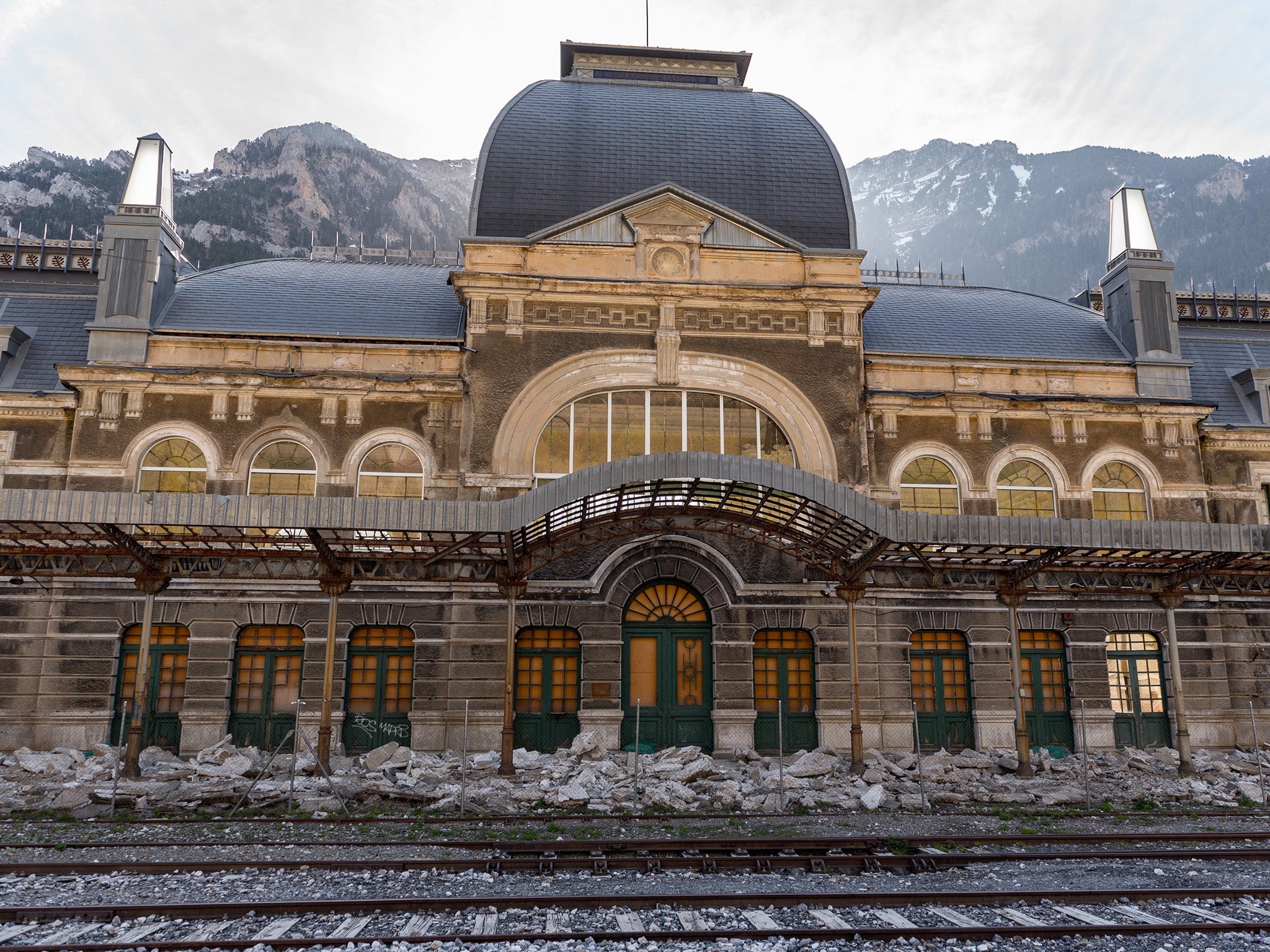Journey through history: Train station where Jews escaped Germany and Nazis smuggled gold to reopen
The station has been closed since 1970 and behind the ornate facades, Canfranc has a sometimes troubling past, reports Graham Keeley in Spain


A grandiose railway station that was both an escape route for thousands of wartime Jews and a key junction for an illicit trade in Nazi gold is to reopen half a century after its closure.
The international terminal in Canfranc in the Pyrenees on the border between Spain and France was built in the style of a French chateau and was once dubbed the “Titanic of the Mountains” because of its size.
Fifty years after the station closed and fell into disrepair, it will reopen again next month after an ambitious restoration programme that symbolises the original spirit that led to its creation: unity between Spain and France.
The vast dilapidated station, which was carved out of stone and is ten times the size of St Pancras, has a high slate roof crowned by domes and balustrades.
Half a century ago, the brakes failed on a French freight train climbing through the Pyrenees and it careered down the hill at 100 kmh and crashed into a wrought iron bridge, which collapsed.
Nobody was hurt but the accident led to the closure of the Pyrenean rail line between France and Spain.
The idea of a cross-border Pyrenean line was mooted in 1865, but work, which involved digging a five-mile tunnel on the French side, took so long that it was only inaugurated in 1928.
Situated in a valley in the Aragon region in eastern Spain, the station and adjoining hotel at the border in Canfranc are jointly controlled by Spain and France.
Since 1970, the French section of track has been closed, with freight carried over the border by an average of 346 lorries a day.
During the Second World War, it became a vital point of escape for thousands of Jews fleeing persecution in Nazi Europe.
With the help of sympathetic French customs officials, Jewish refugees would travel to Canfranc and change for trains onwards to other parts of Spain and eventually freedom in Britain and the United States.
The painters Marc Chagall and Max Ernst, and the singer Josephine Baker, whose husband was Jewish, were among those who escaped to freedom through the ornate station.
“We know that between 1940 and 1942, about 15,000 Jewish and other refugees managed to travel through Canfranc and made it to safety, eventually settling in the US and other countries,” said Ramon J Campo, a journalist who has written a series of books about the history of Canfranc.
“Then when Germany took control in 1942, they detained 277 Jewish people and sent them to a concentration camp in Spain. Most survived.”
The trade in Nazi gold was uncovered years after the war by chance.
In 2000, Jonathan Díaz, who drove a bus between Canfranc and the French town of Oloron-Saint Maire, was waiting to leave on a grey November morning. To kill the time, he went over to the railway lines which were overgrown.
There he found a pile of fading war time customs documents, which appeared to have been damaged by rats or insects. When he looked at them more closely his eyes lit up when he saw the words “Three Tons of Gold Bars”. Díaz realised he had chanced upon a “piece of history”.
“The papers revealed that 86.6 tonnes of plundered Nazi gold was heading from Germany into Spain and Portugal to pay for vital wolfram, which Hitler needed to make tanks and other weapons,” said Campo.
“These papers proved that Spain and Portugal had collaborated with Nazi Germany.”
During the war, Spain and Portugal were officially neutral. However, General Franco, the fascist dictator who ruled Spain after winning a bitterly divisive civil war, and Antonio Oliveira Salazar, the Portuguese dictator, had worked illicitly to help the Germans.
Apart from this clandestine trade in gold, Canfranc was a nest for spies. The station has been described as the “Casablanca of the Pyrenees”.
Albert Le Lay, the head of customs on the French side, has been described as the Schindler of Canfranc because of the way he helped people to escape across the border into Spain.
When the Germans took over the station in 1942, Le Lay also passed information to the British consulate in San Sebastian in Spain and worked for the Resistance.
He staged an audacious escape when he became aware that the Gestapo was about to arrest him.
Le Lay walked with his wife and one of his children into the Spanish town of Canfranc, took a taxi to Zaragoza and then went onto Madrid.
Eventually, the British embassy in Madrid, managed to hide him in a car which drove to Seville. From there he escaped in a boat to Gibraltar before finally finishing up in French-occupied Algeria.
After the war, Le Lay was decorated by the United States and General de Gaulle asked him to be a minister in his government, which he refused.
“After the Germans were forced to flee from Canfranc, they sang Marseillaise which was quite something to do at the time as Franco was ruling Spain and he had been sympathetic to Hitler,” said Campo.
Domestic trains have continued to run to Canfranc from Zaragoza.
The Spanish side of the track will reopen next month linking Canfranc to other Spanish cities.
In France, officials want to do their bit, too, by reopening a 20-mile line that would link to the Spanish track. The European Union will meet 65 per cent of the €4.7m cost.
Alain Rousset, chairman of the New Aquitaine regional council over the border in France, said: “I don’t know if there is a more beautiful European project.”



Join our commenting forum
Join thought-provoking conversations, follow other Independent readers and see their replies
Comments